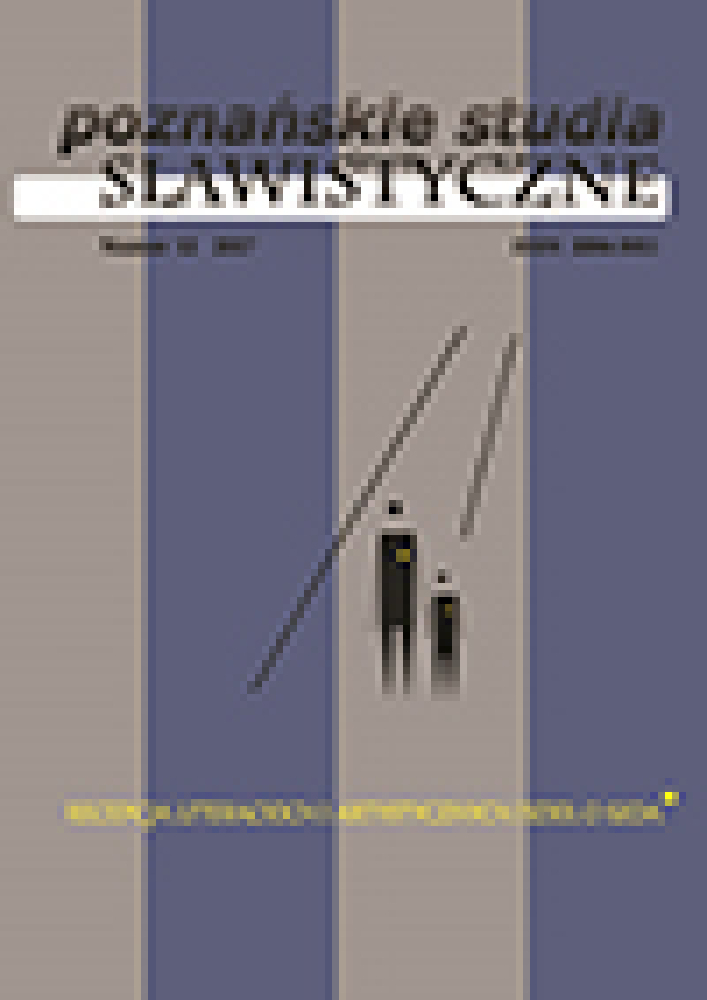Abstract
The article examines genocide as a category that has been used and abused in various, especially historical, political, and ideological, discourses. It considers whether the extermination of Jews (the Holocaust) should be studied in the context of other mass crimes. I investigate various sources of twentieth-century organized violence and their literary representations. I also discuss the works of Polish literature (by Nałkowska, Gębarski, Woroszylski, and Margolis), which depict twentieth- -century acts of genocide (the extermination of Jews and Armenians, in particular) in the context of other mass crimes.References
Applebaum A., 2003, Gulag: a History, New York.
Auron Y., 2009, The Banality of Indifference: Zionism and the Armenian Genocide, New Brunswick.
Besançon A., 2000, Przekleństwo wieku. O komunizmie, narodowym socjalizmie i jedyności Zagłady, trans. J. Guze, Warszawa.
Bruneteau B., 2005, Wiek ludobójstwa, trans. B. Spieralska, Warszawa.
Bujnicki T., 1986, Wstęp, in: H. Sienkiewicz, Wybór nowel i opowiadań, Wrocław, pp. III–CXVIII.
Casas B. de las, 1992, A Short Account of the Destruction of the Indies, trans. N. Griffin, London–New York.
Chekhov A., 1967, The Island: a Journey to Sakhalin, trans. L. Terpak, M. Terpak, New York.
Chekhov A., 2002, Ward No. 6, in: A. Chekhov, Ward No. 6 and other stories, 1892– –1895, trans. R. Wilks, London–New York.
Conrad J.,1897, An Outpost of Progress, “Cosmopolis: An International Review” No. 18, pp. 609–620; No. 19, pp. 1–15.
Conrad J., 1999, Heart of Darkness, in: J. Conrad, Heart of Darkness & Other Stories, London, pp. 29–106.
Dostoevsky F., 1948, The House of the Dead, trans. C. Garnett, London.
Gębarski B., 1961, List do starego tureckiego znajomego, “Kierunki” No. 47, pp. 6–7.
Głowiński M., 1998, Windą – do nieba, in: M. Głowiński, Przywidzenia i figury. Małe szkice 1977–1997, Kraków.
Goldhagen D.J., 2009, Worse than War: Genocide, Eliminationism, and the Ongoing Assault on Humanity, New York.
Hatzfeld J., 2005, Machete Season: the Killers in Rwanda Speak, New York.
Herling G., 1951, A World Apart: the Journal of a Gulag Survivor, London.
Herling-Grudziński G., 1953, Inny Świat. Zapiski sowieckie, London.
Hochschild A., 1998a, Les fantômes du roi Léopold II: un holocauste oublié, trans. M.-C. Elsen, F. Straschitz, Paris.
Hochschild A., 1998b, King Leopold’s Ghost: a Story of Greed, Terror, and Heroism in Colonial Africa, Boston.
Hochschild A., 2012, Duch króla Leopolda. Opowieść o chciwości, terrorze i bohaterstwie w kolonialnej Afryce, trans. P. Tarczyński, Warszawa.
Jastrun M., 1962, Podobny do bogów, in: M. Jastrun, Mit śródziemnomorski, Warszawa, pp. 5–21.
Kafka F., 1987, In the Penal Colony, trans. W. Muir, E. Muir, New York.
Kiedrzyńska W., 1947, Przegląd wspomnień z obozów i więzień hitlerowskich, “Dzieje Najnowsze” issue 1, pp. 161–173.
Kubiak M., 1981, Tacy byliśmy. Wspomnienia więźnia nr 15262 z KL Auschwitz, Warszawa.
Lemarchand R., 2009, The Dynamics of Violence in Central Africa, Philadelphia.
https://doi.org/10.9783/9780812202595
Lindqvist S., 1996, Exterminate All the Brutes, trans. J. Tate, New York.
Lindqvist S., 2007, Terra Nullins: a Journey through No One’s Land, trans. S. Death, New York.
Lukas R.C., 1986, The Forgotten Holocaust: the Poles under German Occupation, Lexington.
Margolis A., 2001, Moralność czasu Holokaustu, “Tygodnik Powszechny” No. 12, “Kontrapunkt” supplement No. 1/2, p. 13.
Midlarsky M.I., 2005, The Killing Trap: Genocide in the Twentieth Century, Cambridge–New York.
Miłosz C., 1994, Nobel Lecture, w: Nobel Lectures Including Presentation Speeches and Laureates’ Biographies: Literature 1968–1980, ed. A. Sture, Singapore, pp. 190–197.
Morawiec A., 2015, Echa zagłady Ormian w literaturze polskiej, “Slavia Occidentalis” No. 2, pp. 7–30.
Nałkowska Z., 1927, Choucas. Powieść internacjonalna, Warszawa.
Nałkowska Z., 1980, Dzienniki, Vol. 3, ed. H. Kirchner, Warszawa.
Nałkowska Z., 2000, Medallions, trans. D. Kuprel, Evanston.
Olusoga D., Erichsen C.W., 2010, The Kaiser’s Holocaust. Germany’s Forgotten Genocide and the Colonial Roots of Nazism, London.
Ringelblum E., 1983, Kronika getta warszawskiego wrzesień 1939–styczeń 1943, ed. A. Eisenbach, trans. A. Rutkowski, Warszawa.
Różewicz T., 1976, The Survivor, in: T. Różewicz, “The survivor” and Other Poems, transl. M.J. Krynski, R.A. Maguire, Princeton, pp. 8–9.
Semelin J., 2003, Analysis of a Mass Crime: Ethnic Cleansing in the Former Yugoslavia, 1991–1999, in: The Specter of Genocide: Mass Murder in Historical Perspective, eds. R. Gellately, B. Kiernan, Cambridge, pp. 353–370.
Sienkiewicz H., 1973, Sachem, in: H. Sienkiewicz, Western Septet: Seven Stories of the American West, trans. M. Moore Coleman, Cheshire, pp. 145–151.
Stannard D.E., 1992, American Holocaust: the Conquest of the New World, New York.
Szawłowski R., 2008, Rafał Lemkin (1900–1959) – polski prawnik twórcą pojęcia „ludobójstwo”, in: Zbrodnie przeszłości. Opracowania i materiały prokuratorów IPN, vol. 2, Ludobójstwo, eds. R. Ignatiew, A. Kura, Warszawa, pp. 7–22.
Szlengel W., What I Read to the Dead, trans. A.M. Kobos, , 01.12.2015.
Śliwowski R., 1986, Antoni Czechow, Warszawa.
Śliwowski R., 1989, Wstęp, in: A. Czechow, Opowiadania i opowieści (Wybór), trans. I. Bajkowska [et al.], Wrocław, pp. III–XCVIII.
Ternon Y., 1981, The Armenians: History of a Genocide, trans. R.C. Cholakian, Delmar.
Thucydides, 1980, The History of the Peloponnesian War, trans. R. Crawley, Franklin.
Traverso E., 2003, The Origins of Nazi Violence, trans. J. Lloyd, New York.
Werfel F., 1937, The Forty Days of Musa Dagh, trans. G. Dunlop, New York.
Woroszylski W., 1970, Zagłada gatunków, in: W. Woroszylski, Zagłada gatunków, Warszawa, pp. 3–6.
Woroszylski W., 1977, Literatura. Powieść, Paryż.
License
Copyright (c) 2017 Arkadiusz Morawiec

This work is licensed under a Creative Commons Attribution-NoDerivatives 4.0 International License.
